-
 Bitcoin
Bitcoin $116900
-1.92% -
 Ethereum
Ethereum $3655
-2.43% -
 XRP
XRP $3.093
-4.38% -
 Tether USDt
Tether USDt $1.000
-0.01% -
 BNB
BNB $776.8
-0.50% -
 Solana
Solana $182.5
-3.18% -
 USDC
USDC $1.000
0.01% -
 Dogecoin
Dogecoin $0.2287
-4.43% -
 TRON
TRON $0.3155
0.17% -
 Cardano
Cardano $0.7984
-2.54% -
 Hyperliquid
Hyperliquid $43.05
0.67% -
 Sui
Sui $3.849
0.16% -
 Stellar
Stellar $0.4215
-2.84% -
 Chainlink
Chainlink $17.83
-3.09% -
 Hedera
Hedera $0.2553
4.41% -
 Bitcoin Cash
Bitcoin Cash $540.3
4.62% -
 Avalanche
Avalanche $23.51
-2.54% -
 Litecoin
Litecoin $111.8
-1.52% -
 UNUS SED LEO
UNUS SED LEO $8.984
0.11% -
 Shiba Inu
Shiba Inu $0.00001370
-1.24% -
 Toncoin
Toncoin $3.145
-0.85% -
 Ethena USDe
Ethena USDe $1.001
-0.04% -
 Polkadot
Polkadot $4.014
-1.63% -
 Uniswap
Uniswap $10.17
-2.84% -
 Monero
Monero $323.8
0.43% -
 Dai
Dai $1.000
0.01% -
 Bitget Token
Bitget Token $4.509
-2.87% -
 Pepe
Pepe $0.00001220
-4.37% -
 Aave
Aave $290.9
-0.67% -
 Cronos
Cronos $0.1286
0.99%
FPGA 광부 란 무엇입니까?
FPGA 광부는 재구성 성과 에너지 효율을 제공하여 광부가 다양한 암호 화폐 및 알고리즘에 적응할 수 있지만 기술 전문 지식이 필요하고 초기 비용이 높습니다.
2025/04/16 05:56

FPGA 광부 또는 필드 프로그래밍 가능한 게이트 어레이 광부는 FPGA의 유연성과 효율성을 활용하는 암호 화폐 채굴에 사용되는 하드웨어 유형입니다. FPGA 광부는 특정 작업을 위해 설계되어 재 프로그래밍 할 수없는 기존 ASIC (Application-Specific Integrated Circuit) 광부와 달리 재구성 가능하다는 이점을 제공합니다 . 이는 다른 암호 화폐를 채굴하거나 채굴 알고리즘의 변화에 적응하도록 업데이트 될 수 있음을 의미하므로, 빠르게 진화하는 암호 화폐 세계에서 앞서 나가려는 광부들에게 다재다능한 선택이됩니다.
FPGA 광부의 작동 방식
FPGA 광부는 특정 작업을 수행하도록 구성 할 수있는 프로그래밍 가능한 논리 블록의 그리드를 사용하여 작동합니다. cryptocurrency 마이닝의 맥락에서, 이러한 작업에는 일반적으로 복잡한 수학적 문제를 해결하여 트랜잭션을 검증하고 블록 체인에 추가하는 것이 포함됩니다. FPGA 마이닝의 핵심은 이러한 작업을 효율적으로 실행하도록 FPGA를 프로그래밍하는 기능입니다 . 이는 Verilog 또는 VHDL과 같은 하드웨어 설명 언어 (HDL)를 사용하여 광부가 FPGA의 작업을 광업중인 Cryptocurrency의 특정 요구 사항에 맞게 조정할 수 있도록합니다.
FPGA 광부의 장점
FPGA 광부의 주요 장점 중 하나는 에너지 효율 입니다. GPU (그래픽 처리 장치) 및 CPU (중앙 처리 장치)와 비교하여 FPGA는 동일한 마이닝 작업을 수행하면서 전력을 덜 소비합니다. 이로 인해 시간이 지남에 따라 상당한 비용 절감이 발생할 수 있습니다. 또한 FPGA의 재 프로그래밍 성을 통해 광부는 새 하드웨어를 구매하지 않고도 다른 암호 화폐 사이를 전환 할 수 있으므로 ASIC 광부에서는 사용할 수없는 수준의 유연성을 제공합니다.
FPGA 광부의 단점
그들의 장점에도 불구하고 FPGA 광부들도 몇 가지 단점을 가지고 있습니다. FPGA 하드웨어의 초기 비용은 높을 수 있으며 광업을위한 FPGA를 프로그래밍하고 최적화하는 프로세스는 복잡하고 시간이 많이 걸릴 수 있습니다. 이를 위해서는 모든 광부가 접근 할 수없는 일정 수준의 기술 전문 지식이 필요합니다. 또한, FPGA는 ASIC보다 다재다능하지만 일반적으로 와트 당 해시 속도 측면에서 덜 효율적이므로 경쟁이 치열한 광업 환경에서는 불리 할 수 있습니다.
FPGA 광부 설정
FPGA 광부를 설정하려면 여러 단계가 필요하며 각 단계가 필요합니다. 각 단계는 세부 사항에주의를 기울여야합니다. 다음은 시작하는 데 도움이되는 단계별 가이드입니다.
올바른 FPGA 보드를 선택하십시오 . 채굴에 적합한 FPGA 보드를 선택하십시오. 인기있는 선택으로는 Xilinx Zynq 또는 Intel Cyclone 시리즈가 있습니다. 전력 소비, 가용 리소스 및 마이닝 소프트웨어와의 호환성과 같은 요소를 고려하십시오.
필요한 소프트웨어 설치 : FPGA를 프로그래밍하고 제어하려면 소프트웨어가 필요합니다. 여기에는 일반적으로 Xilinx Vivado 또는 Intel Quartus Prime과 같은 통합 개발 환경 (IDE)과 선택한 암호 화폐와 호환되는 마이닝 소프트웨어가 포함됩니다.
FPGA 프로그램 : IDE를 사용하여 HDL에서 마이닝 알고리즘을 작성하고 컴파일하십시오. 이는 복잡한 프로세스 일 수 있으며 기존 오픈 소스 프로젝트를 참조하거나 숙련 된 FPGA 광부의 지침을 찾아야 할 수도 있습니다.
광업 풀에 연결하십시오 : FPGA가 프로그래밍되면 채굴 풀에 연결하십시오. 여기에는 필요한 네트워크 연결을 설정하고 풀 서버와 통신하기 위해 마이닝 소프트웨어를 구성하는 것이 포함됩니다.
모니터링 및 최적화 : FPGA 광부가 가동되고 실행 된 후에는 성능을 모니터링하고 필요에 따라 조정하십시오. 여기에는 마이닝 알고리즘을 조정하거나 효율성을 향상시키기 위해 FPGA 설정을 조정하는 것이 포함될 수 있습니다.
FPGA 광부 대 ASIC 광부
FPGA 광부를 ASIC 광부와 비교할 때 각각의 강점과 약점을 고려하는 것이 중요합니다. ASIC 광부는 고도로 전문화되어 있으며 와트 당 해시 속도 측면에서 우수한 성능을 제공하므로 단일 암호 화폐에 중점을 둔 광부에게 선호되는 선택입니다. 그러나 유연성 부족은 채굴 알고리즘이 변경되거나 광부가 다른 암호 화폐로 전환하려는 경우 쓸모 없게 될 수 있음을 의미합니다. 반면에 FPGA 광부는 성능과 유연성의 균형을 제공하여 적응성과 에너지 효율성을 높이는 광부에게 적합한 선택입니다.
FPGA 광부 대 GPU 광부
FPGA 광부는 여러 가지 주요 방식으로 GPU 광부와 다릅니다. GPU는 광범위하게 이용 가능하고 광업을 위해 비교적 쉽게 설정하여 초보자에게 인기있는 선택입니다. 그러나 FPGA보다 에너지 효율이 적고 특정 암호 화폐를 채굴하는 데 덜 효과적 일 수 있습니다. 에너지 효율이 높고 재 프로그래밍 성을 갖는 FPGA 광부는 광부에게 올바르게 설정하기위한 시간과 노력을 기꺼이 투자하려는 광부에게 더 나은 장기 가치를 제공 할 수 있습니다 .
FPGA 광부의 실제 응용 프로그램
FPGA 광부는 cryptocurrency 공간 내의 다양한 실제 응용 프로그램에서 성공적으로 사용되었습니다. 예를 들어, 일부 광부는 FPGA를 사용하여 초기에 Bitcoin를 채굴하여 채굴 알고리즘의 변화에 적응할 수있는 유연성을 활용했습니다. 보다 최근에, FPGA는 경쟁력이 떨어지고 기능에 더 적합한 알트 코인을 채굴하는 데 사용되었습니다. 경우에 따라 광부는 효율성과 수익성을 극대화하기 위해 FPGA에 대한 맞춤형 마이닝 알고리즘을 개발했습니다 .
자주 묻는 질문
Q : FPGA 광부를 사용하여 암호 화폐를 채굴 할 수 있습니까?
A : FPGA는 다재다능하고 다른 암호 화폐를 채굴하도록 프로그래밍 할 수 있지만 모든 암호 화폐가 FPGA 마이닝에 똑같이 적합한 것은 아닙니다. 일부 cryptocurrencies, 특히 ASIC 내성 알고리즘이있는 것들은 GPU 또는 기타 하드웨어를 사용하여보다 효과적으로 채굴 될 수 있습니다. FPGA가 최선의 선택인지 확인하기 위해 광업에 관심이있는 특정 암호 화폐를 조사하는 것이 중요합니다.
Q : 채굴을 위해 FPGA를 프로그래밍하는 데 얼마나 걸립니까?
A : 채굴을 위해 FPGA를 프로그래밍하는 데 걸리는 시간은 경험 수준과 채굴 알고리즘의 복잡성에 따라 크게 다를 수 있습니다. 초보자의 경우 필요한 기술을 배우고 작업 마이닝 알고리즘을 개발하는 데 몇 주가 걸릴 수 있습니다. 숙련 된 광부는 며칠 만에 FPGA를 프로그래밍 할 수 있습니다.
Q : FPGA 광부는 수익성이 있습니까?
A : FPGA 광부의 수익성은 전기 비용, 채굴되는 암호 화폐 가격 및 FPGA 설정의 효율을 포함한 여러 요인에 달려 있습니다. 경우에 따라 FPGA 광부는 특히 경쟁이 치열한 암호 화폐를 채굴하는 데 수익성이있을 수 있습니다. 그러나 채굴에 FPGA를 사용하기로 결정하기 전에 초기 투자 및 지속적인 유지 보수 비용을 신중하게 고려해야합니다.
Q : 채굴에 기존 FPGA 설계를 사용할 수 있습니까?
A : 그렇습니다. 광업의 출발점으로 사용할 수있는 오픈 소스 FPGA 설계가 있습니다. 그러나 이러한 설계는 특정 하드웨어와 광업에 대한 암호 화폐에 대해 수정 및 최적화해야 할 수도 있습니다. 기존 디자인을 사용하면 시간과 노력을 절약 할 수 있지만 기본 코드를 이해하고 최적의 성능을 달성하기 위해 필요한 조정을하는 것이 중요합니다.
부인 성명:info@kdj.com
제공된 정보는 거래 조언이 아닙니다. kdj.com은 이 기사에 제공된 정보를 기반으로 이루어진 투자에 대해 어떠한 책임도 지지 않습니다. 암호화폐는 변동성이 매우 높으므로 철저한 조사 후 신중하게 투자하는 것이 좋습니다!
본 웹사이트에 사용된 내용이 귀하의 저작권을 침해한다고 판단되는 경우, 즉시 당사(info@kdj.com)로 연락주시면 즉시 삭제하도록 하겠습니다.
- Token6900 : 다음 큰 밈 동전? 사전 판매가 열을 나눕니다!
- 2025-07-26 05:30:35
- Ondo 브레이크 아웃 평가 : 고래, 지갑 및 다음은 무엇입니까?
- 2025-07-26 05:30:35
- 카스파의 가장 강력한 달 공개 : 새로운 데이터 충격 카스 트레이더!
- 2025-07-26 04:30:12
- 국경 간 지불 혁명 : 청구를 선도하는 Stablecoins 및 지불 제공 업체
- 2025-07-26 04:50:12
- Robinhood Listing 이후 Hedera (HBAR) 로켓 : 가격 서지 및 다음의 요점
- 2025-07-26 06:10:11
- Coinstore의 Microbitcoin (MBC) : 층 -2 토큰 화를 사용한 미세 지불 혁신
- 2025-07-26 06:10:11
관련 지식
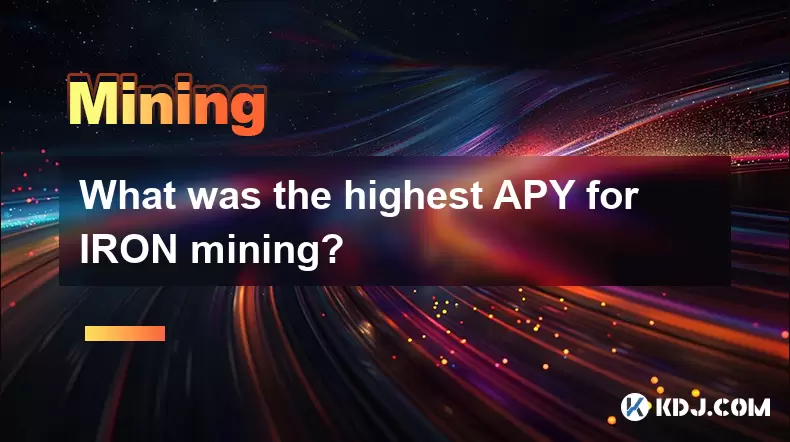
철 채굴의 가장 높은 Apy는 무엇입니까?
2025-07-23 05:14:36
철 토큰과 채굴 메커니즘을 이해합니다 Iron Token 은 철제 금융 생태계 내에서 작동하는 스타블 레코 인이며, 주로 Polygon 및 Binance Smart Chain과 같은 블록 체인 네트워크에서 작동합니다. 그것은 부분 담보 모델을 통해 미국 달러로 1 : ...

철 풀에서 불완전한 손실은 무엇입니까?
2025-07-23 09:00:41
철 풀의 맥락에서 불완전한 손실을 이해합니다 불완전한 손실은 분산 금융 (DEFI) 플랫폼, 특히 자동화 된 시장 제조업체 (AMM) 모델을 사용하는 유동성 제공 업체에 영향을 미치는 현상입니다. 철제 금융 생태계 의 일부인 철 풀의 맥락에서, 유동성 풀에 추가 된 후...
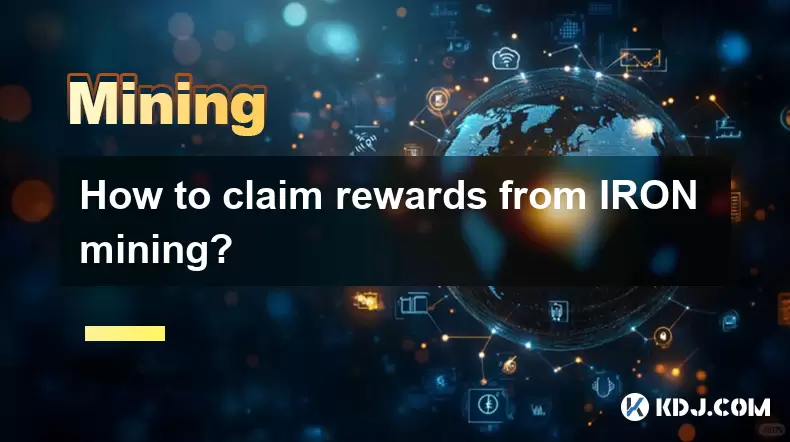
철 채굴로부터 보상을 청구하는 방법?
2025-07-23 14:21:39
철 채굴 및 보상 메커니즘 이해 Iron Finance는 다각형 및 Binance 스마트 체인 네트워크에서 분산 된 금융 (Defi) 프로토콜로 운영되어 철 및 타이탄 으로 구성된 이중 토로 시스템을 도입했습니다. 이 프로토콜을 통해 사용자는 지정된 풀에 자산을 제공하...
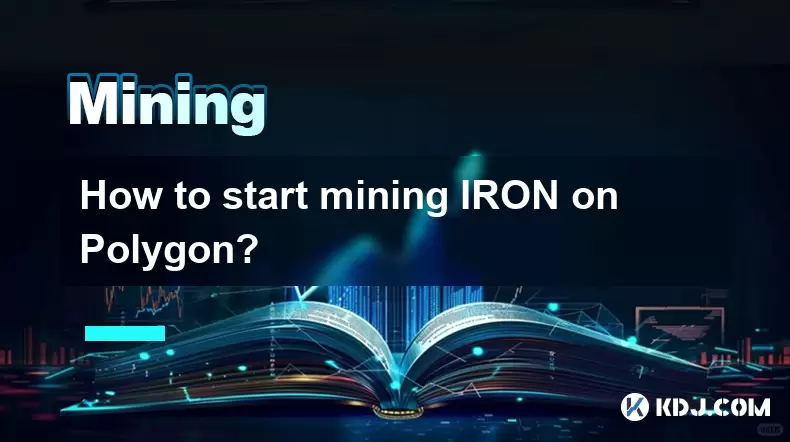
다각형에서 철분을 채굴하는 방법?
2025-07-23 20:00:37
철분과 다각형에 대한 역할을 이해합니다 철은 미국 달러로 1 : 1 페그를 유지하도록 설계된 분산 된 알고리즘 스타블 코인입니다. 다각형 (이전의 Matic Network)을 포함한 여러 블록 체인 네트워크에서 운영되며, 이는 낮은 트랜잭션 수수료와 높은 처리량을 제공...
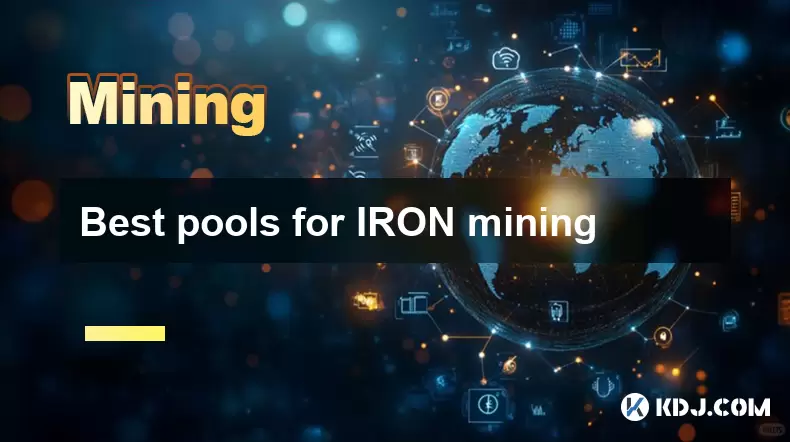
철 채굴을위한 최고의 수영장
2025-07-26 03:56:42
철 채굴 및 독특한 메커니즘을 이해합니다 Iron (Iron Finance)은 다중 체인 알고리즘 스타블 레코 인 생태계를 만드는 것을 목표로하는 분산 금융 (DEFI) 프로젝트였습니다. 은행 운영으로 인해 20121 년 중반에 원래 철 토큰이 무너졌지만, 이후 다양한...
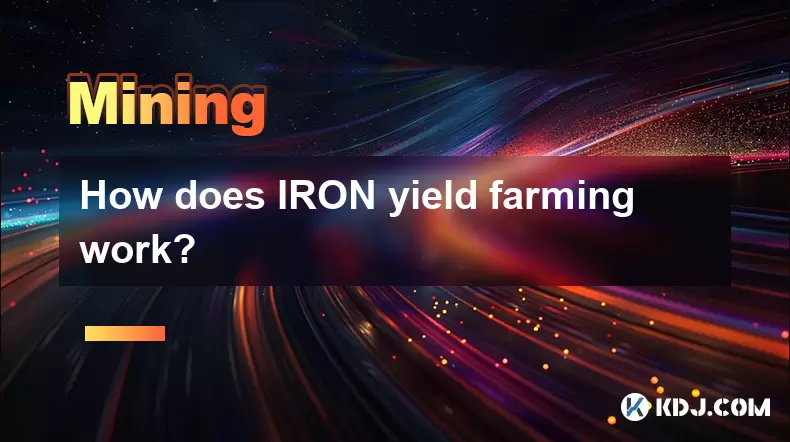
아이언은 어떻게 농업을 생산합니까?
2025-07-23 22:14:36
철률 농업 및 핵심 메커니즘을 이해합니다 철 생산량 농업은 블록 체인 플랫폼의 특정 토큰 풀에 유동성을 제공함으로써 사용자가 보상을받을 수있는 분산 된 금융 (DEFI) 전략입니다. Iron Token 은 일반적으로 Iron Finance Ecosystem과 관련이 있...

철 채굴의 가장 높은 Apy는 무엇입니까?
2025-07-23 05:14:36
철 토큰과 채굴 메커니즘을 이해합니다 Iron Token 은 철제 금융 생태계 내에서 작동하는 스타블 레코 인이며, 주로 Polygon 및 Binance Smart Chain과 같은 블록 체인 네트워크에서 작동합니다. 그것은 부분 담보 모델을 통해 미국 달러로 1 : ...

철 풀에서 불완전한 손실은 무엇입니까?
2025-07-23 09:00:41
철 풀의 맥락에서 불완전한 손실을 이해합니다 불완전한 손실은 분산 금융 (DEFI) 플랫폼, 특히 자동화 된 시장 제조업체 (AMM) 모델을 사용하는 유동성 제공 업체에 영향을 미치는 현상입니다. 철제 금융 생태계 의 일부인 철 풀의 맥락에서, 유동성 풀에 추가 된 후...

철 채굴로부터 보상을 청구하는 방법?
2025-07-23 14:21:39
철 채굴 및 보상 메커니즘 이해 Iron Finance는 다각형 및 Binance 스마트 체인 네트워크에서 분산 된 금융 (Defi) 프로토콜로 운영되어 철 및 타이탄 으로 구성된 이중 토로 시스템을 도입했습니다. 이 프로토콜을 통해 사용자는 지정된 풀에 자산을 제공하...

다각형에서 철분을 채굴하는 방법?
2025-07-23 20:00:37
철분과 다각형에 대한 역할을 이해합니다 철은 미국 달러로 1 : 1 페그를 유지하도록 설계된 분산 된 알고리즘 스타블 코인입니다. 다각형 (이전의 Matic Network)을 포함한 여러 블록 체인 네트워크에서 운영되며, 이는 낮은 트랜잭션 수수료와 높은 처리량을 제공...

철 채굴을위한 최고의 수영장
2025-07-26 03:56:42
철 채굴 및 독특한 메커니즘을 이해합니다 Iron (Iron Finance)은 다중 체인 알고리즘 스타블 레코 인 생태계를 만드는 것을 목표로하는 분산 금융 (DEFI) 프로젝트였습니다. 은행 운영으로 인해 20121 년 중반에 원래 철 토큰이 무너졌지만, 이후 다양한...

아이언은 어떻게 농업을 생산합니까?
2025-07-23 22:14:36
철률 농업 및 핵심 메커니즘을 이해합니다 철 생산량 농업은 블록 체인 플랫폼의 특정 토큰 풀에 유동성을 제공함으로써 사용자가 보상을받을 수있는 분산 된 금융 (DEFI) 전략입니다. Iron Token 은 일반적으로 Iron Finance Ecosystem과 관련이 있...
모든 기사 보기

























































































